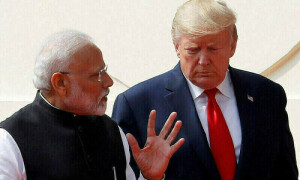Unloved and in chains — Kaavan

Imagine losing a loved one and then being punished for it.
Imagine being shackled; unable to move for four long years.
That is the sad reality of the only elephant at Islamabad's Marghazar Zoo — Kaavan.
A gift to Pakistan from Sri Lanka, Kaavan was brought to the zoo in 1985. His only partner Saheli died in 2012 after which he has been alone, chained and virtually neglected.
Elephants are known for their close family ties and social complexity. In short, elephants need to be in groups and they require large enclosures - you don't have to be a wildlife conservationist to know that. It's just baffling to me that the Capital Development Authority (CDA) did not act promptly to get Kaavan a new partner four years ago.
Read: Kaavan — Marghazar Zoo’s only attraction
It was only after good citizens took it upon themselves to tell Kavaan's story to the world, that the CDA, caving into international pressure, unchained him last year in September 2015.
I visited him after the unshackling, standing by the zoo's pool, chewing down bananas, Kavaan was what he hasn't been in years: happy.
Sadly, the happiness was short-lived. Kavaan is in chains again.
According to the zoo director, Kaavan's shed and enclosure were poorly built and needed to be reconstructed. It's difficult to imagine why Kavaan couldn't just be shifted to an open space until then. Why repeatedly distress the animal?
Since he is tied on all fours, Kavaan is unable move for hours at a stretch, this puts stress on his joints and feet and can potentially result in an injury. A foot injury can be fatal for an elephant because if it collapses, the weight of the body can crush its organs.
Another reason quoted by the zoo director for Kavaan's chaining is that he is in 'musth' — a condition where male elephants undergo hormonal changes and become highly aggressive. Surely, the chains are not helping.
When the Chairman of the Pakistan Wildlife Foundation Safwan Ahmad visited Kaavan's enclosure, he came to the conclusion that the elephant was being fed a nutrient-deficient diet, and that he exhibits behavioral issues due to a lack of social stimulation, adequate space and environmental enrichment.
The zoo director had nothing to say in his defence.
Following his rechaining, I've visited Kaavan a few times and on each occasion, I have painfully watched him standing inside his tiny enclosure, bobbing his head from left to right — this behaviour is known as weaving and is an indication of high stress.
Also read: Karachi Zoo — where animals come to die
Elephants are known to have exceptionally good memories; it's likely that Kaavan is highly self-aware of the treatment being meted out to him by the zoo administration. And that, in itself is a heartbreaking thought to me.
Being an animal lover, I would want to see nothing more than the zoos in Pakistan thriving. But if year after year, we keep failing to create an environment conducive for animals, I would much rather we rethink having any zoos in the country at all.















































